Beyond Style: Examining the Intricate Web of Significance Weaved Into the Salwar Kameez
The salwar kameez is one of the most evocative pieces of clothing. Across South Asia and beyond, this two-piece ensemble—loose-fitting pants, or salwar, and a tunic, or kameez—serves as a powerful emblem of social paradigm shift, religious expression, and cultural identification. Its centuries-long journey through many cultures presents an intriguing story entwined with custom, adaptability, and individual expression.
A History-Driven Legacy:
- Mughal Origins: It is thought that the clothing worn by Central Asian tribes who immigrated to the Indian subcontinent during the Mughal Empire (16th–18th century) is where the salwar kameez first appeared. The Mughals, known for their love of creative embellishments, added elaborate embroidery and luxurious textiles, giving the outfit an air of sophistication and extravagance.
- Evolution and Diffusion: The salwar kameez evolved to suit local inclinations and socioreligious standards over time. While women adopted it more frequently in other places, it became a staple for both men and women in Punjab. The clothing’s appeal soared by the 20th century, overcoming geographical and religious barriers to become a universally acknowledged representation of South Asian identity.
- National Dress: The salwar kameez is still worn by Pakistanis of all ages and genders, and it is considered the country’s national dress. Its significance as an all-encompassing emblem of national pride is highlighted by its appearance on national holidays and cultural events.

A Cultural Expression Canvas:
- Regional Variations: The salwar kameez is a chameleon, changing shape and design to suit the distinct cultural fabric of many locales. In Gujarat, elaborate zardozi embroidery lends a hint of luxury, while vivid block patterns and mirrorwork define the ensemble in Sindh. These variants honor South Asia’s abundant diversity.
- Religious Significance: Another way that people display their religion is through the salwar kameez. The straightforward, baggy style is regarded as suitable clothing for both daily worship and religious rituals in Sikhism. Hindus might wear it on temple visits or religious events. This correlation strengthens the garment’s link to spiritual customs.
- Personalization and Modernity: The salwar kameez is always changing to suit contemporary tastes, all the while honoring its traditional origins. By experimenting with materials, cuts, and embellishments, people can show their individuality and modify the item to fit modern environments. The salwar kameez’s dynamism makes sure it’s still relevant and colorful in the contemporary era.
An Emblematic and Identifiable Symbol:
- Crossing barriers: The salwar kameez has become a globally recognized emblem of South Asian identity, worn by diaspora populations across the globe, transcending geographical barriers. It strengthens their sense of connection and belonging by acting as a potent reminder of their ancestry and cultural background.
- Empowering Women: Especially in South Asia, the salwar kameez has been a major contributor to women’s empowerment. It challenges conventional ideas of feminine modesty and promotes women’s agency and social mobility because of its comfort and practicality, which permit freedom of movement and involvement in a variety of life activities.
- A Statement in Global Fashion: The salwar kameez has gained international recognition in recent times, appearing on fashion runways and on the bodies of famous people. This widespread acknowledgment highlights its artistic appeal and cultural value, demonstrating its capacity to promote understanding amongst people from different cultural backgrounds.
Rajwadi: Rajwadi is a Famous site for Indian Cloths. The salwar kameez is a living representation of South Asia’s rich cultural legacy, not merely a piece of clothing. Its journey, shaped by local adaptations, historical influences, and personal expression, unveils a dynamic story that keeps changing. As it covers bodies all over the world, the salwar kameez creates a rich tapestry of meaning that cuts across boundaries and generations. It is a potent symbol of identity, empowerment, and cross-cultural interchange.